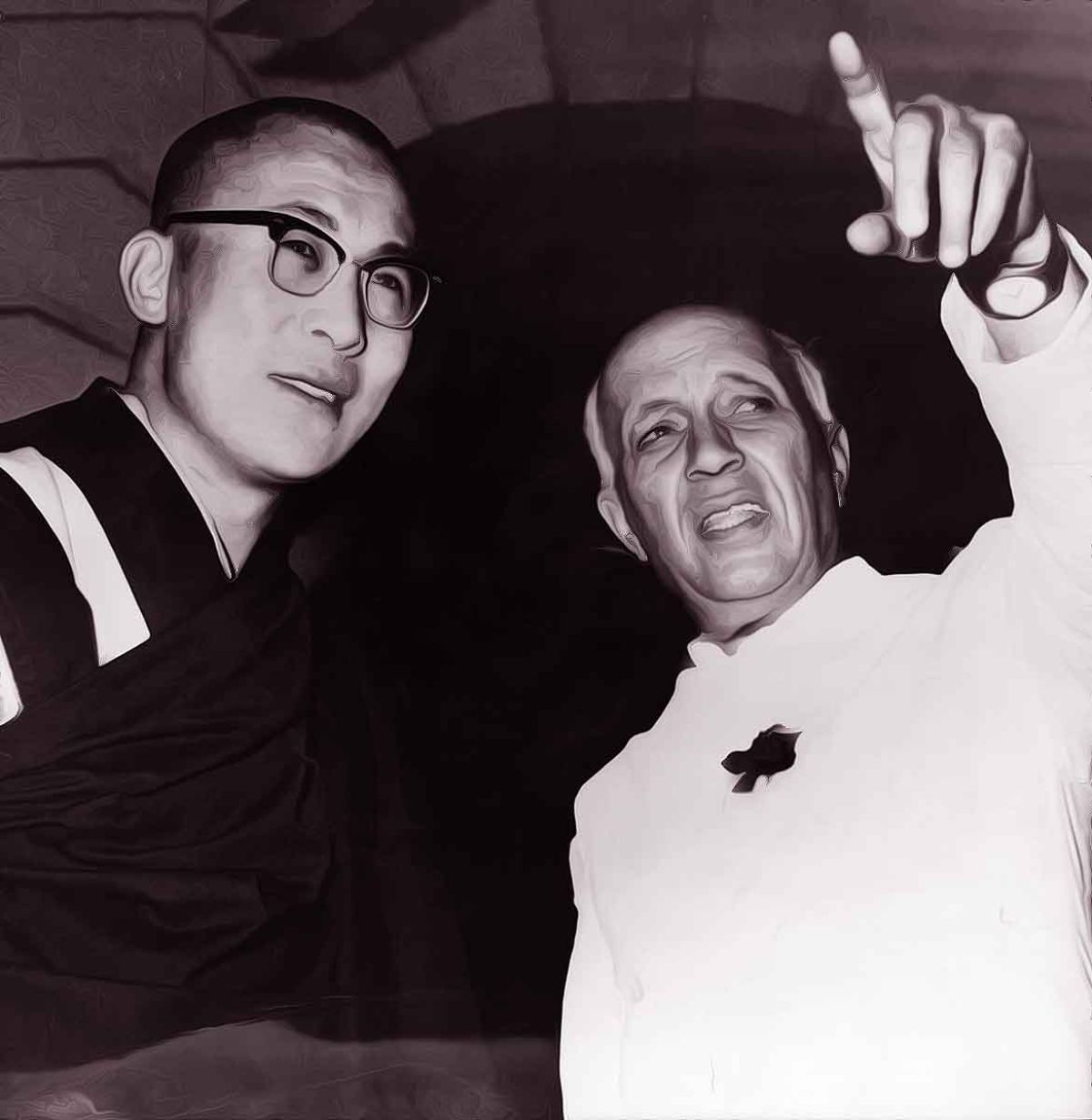Sanatan Articles
Satyaagrah
Written on
Satyaagrah
Written on
Satyaagrah
Written on
Satyaagrah
Written on
Satyaagrah
Written on
JOIN SATYAAGRAH SOCIAL MEDIA
"It's hard for the same people who put you in the ditch to pull you out of it": Nehru's Panchsheel blunder was born in sin to put the seal of approval upon the destruction of an ancient nation which was associated with India spiritually and culturally

“This great doctrine [Panchsheel] was born in sin, because it was enunciated to put the seal of our approval upon the destruction of an ancient nation which was associated with us spiritually and culturally... It was a nation which wanted to live its own life and it sought to have been allowed to live its own life ...” — Acharya Kriplani (Arpi2)
|
Despite what China did to Tibet, India signed the ‘Panchsheel Agreement' with China on 29 April 1954. The agreement itself was titled “Agreement on Trade and Intercourse between the Tibet region of China and India” thus acknowledging Tibet as a part of China. India gained nothing through the Agreement, and all benefits accrued to China. Chinese leaders must have been laughing at the naivete of the Indian leadership.
India did not even insist on the prior settlement of borders. Reportedly, Girija Shankar Bajpai of the External Affairs Ministry had advised on the settlement of the borders prior to the signing of Panchsheel, but his suggestion was ignored by all the three concerned: KM Panikkar, Krishna Menon, and Nehru. Our ambassador to China, KM Panikkar, was later derisively referred to as the “ambassador of China”.
|
Dalai Lama wrote poignantly in his autobiography, “Yet I was conscious that outside Tibet the world had turned its back on us. Worse, India, our nearest neighbor, and spiritual mentor, had tacitly accepted Peking’s claim to Tibet. In April 1954, Nehru signed a new Sino- Indian treaty which included a memorandum known as Panchsheel
...According to this treaty, Tibet was part of China.” (DL/113)
Acharya Kripalani had said on the floor of the Parliament in 1954: “Recently we have entered into a treaty with China [Panchsheel]. I feel that China after it had gone Communist, committed an act of aggression against Tibet. The plea is that China had an ancient right of suzerainty. This right was out of date, old, and antiquated. It was never exercised in fact. It had lapsed by the flux of time. Even if it had not lapsed, it is not right in these days of democracy by which our Communist friends swear, by which the Chinese swear, to talk of this ancient suzerainty and exercise it in a new form in a country that had and has nothing to do with China... England went to war with Germany not because Germany had invaded England, but because it had invaded Poland and Belgium…”(AS/137)
|
Dr Ambedkar disagreed with the Tibet policy of India and felt that “there is no room for Panchsheel in politics”. He said that “if Mr. Mao had any faith in the Panchsheel, he certainly would treat the Buddhists in his own country in a very different way.”
Dr Ambedkar also commented: “The Prime Minister has practically helped the Chinese to bring their border down to the Indian border. Looking at all these things it seems to me that it would be an act of levity not to believe that India if it is not exposed to aggression right now, is exposed to aggression…”(DK/455-6)
|
Wrote Walter Crocker in ‘Nehru: A Contemporary's Estimate’:
“India, step by step, renounced the hard-won special position in Tibet which Britain had bequeathed to her, and she accepted Chinese suzerainty in principle and Chinese sovereignty in fact. Nehru dismissed the notion of Tibet as a buffer state—‘A buffer between whom?’—and described India’s previous special position there as an outmoded relic of imperialism. India’s renunciation was sealed in a series of Sino-Indian agreements, the most important being the Agreement on Trade and… signed in 1954 [Panchsheel]…”(Croc/74-75)
India did this despite its own stand to the contrary earlier. The flag of Tibet was put up on 15 August 1947 in Parliament, acknowledging Tibet as a separate nation. Right up to 1949, Nehru, in his official communications, used words like the Tibet Government, our two countries, and so on, leaving no doubt that India recognized Tibet as a separate, independent nation.
Panchsheel is actually a most eloquent example of the naivety of Indian diplomacy and a shining example of what an international agreement should NOT be! Yet, upon criticism of the Panchsheel in parliament, Nehru had brazenly stated that in the realm of foreign affairs he could never take so much credit as for the India-China settlement over Tibet! An amazingly self-deluding assertion indeed!!
|
REFERENCE:
Unabridged Edition, April 2019 Revised & Enlarged to 127 MAJOR BLUNDERS by Rajnikant Puranik | Book can be purchased from www.rkpbooks.com
 Support Us
Support Us
Satyagraha was born from the heart of our land, with an undying aim to unveil the true essence of Bharat. It seeks to illuminate the hidden tales of our valiant freedom fighters and the rich chronicles that haven't yet sung their complete melody in the mainstream.
While platforms like NDTV and 'The Wire' effortlessly garner funds under the banner of safeguarding democracy, we at Satyagraha walk a different path. Our strength and resonance come from you. In this journey to weave a stronger Bharat, every little contribution amplifies our voice. Let's come together, contribute as you can, and champion the true spirit of our nation.
 |  |  |
| ICICI Bank of Satyaagrah | Razorpay Bank of Satyaagrah | PayPal Bank of Satyaagrah - For International Payments |
If all above doesn't work, then try the LINK below:
Please share the article on other platforms
DISCLAIMER: The author is solely responsible for the views expressed in this article. The author carries the responsibility for citing and/or licensing of images utilized within the text. The website also frequently uses non-commercial images for representational purposes only in line with the article. We are not responsible for the authenticity of such images. If some images have a copyright issue, we request the person/entity to contact us at satyaagrahindia@gmail.com and we will take the necessary actions to resolve the issue.
Related Articles
- "Achievement in space, politics on Earth": While ISRO's Chandrayaan-3 etches a new chapter in space history, the Congress's rush for credit speaks volumes, amidst lunar triumphs, memories of overlooked funding pleas during the UPA era cast long shadows
- If not for Muslim appeasement, Vande Mataram would have been India's National Anthem: the history of Muslim opposition and support
- Winning wars but losing the peace: Sri Krishna and Mahatma
- "लिफ़ाफ़े": PM Museum writes to Sonia and Rahul Gandhi, demanding the return of 51 cartons of Nehru’s letters, including those with Edwina Mountbatten, removed in 2008, the issue was discussed extensively during the AGM of PMML in April 2024
- "Symbols are powerful because they are the visible signs of invisible realities": ‘Sengol’ representing fair & equitable governance will shine in the new Parliament as a national symbol of Amrit Kaal, an era of India taking its rightful place in the world
- Mysterious death of the tallest leader Syama Prasad Mookerjee in Kashmir: He was strong critic of Nehru and founder of Bharatiya Jana Sangh (BJP today)
- Congress created magic on paper to make 17 crores poor by changing the estimated poverty line in a rural area and urban area: PM Modi tears into Congress’ ‘Garibi hatao’ facade, exposes the reality of 2013 report
- "In loyalty's absence, betrayal finds its stage": Indians sacrificed their life earnings to Netaji for a dream called freedom, Nehru, however, fancied a different richness: gifting it to Pakistan, Legacy decisions, they call it was one more great betrayal
- Prophecies of Jogendra Nath Mandal getting real after seventy years of his return from Pakistan
- Tata Group officially takes over the airline from the union government, says we are committed to making it a world-class airline: ‘Golden age of Air India lies ahead’
- "Betrayal is the birthplace of resentment": Diving into murky depths of Nehru & Elwin's policies in Northeast India unveils a legacy of disruption, a region converted, culture exploited & nation betrayed - glaring testament to their ill-conceived actions
- Can Communism and Democracy Coexist - 100 Years of Russian Revolution
- Harmonizing Nathuram Godse: Why India should move beyond denouncing him, a man who altered the course of not only the politics of the country but the very history of the Hindu Civilisation and, by extension, the world at large
- How Nehru's Govt helped China in conquering Tibet and let go of it's centuries old friend
- The perpetrator of the Jallianwala Bagh massacre General Reginald Dyer was forgiven by Mohandas Gandhi as an exercise of forgiveness or love to nurse Dyer back to life if he was suffering from a physical malady





















